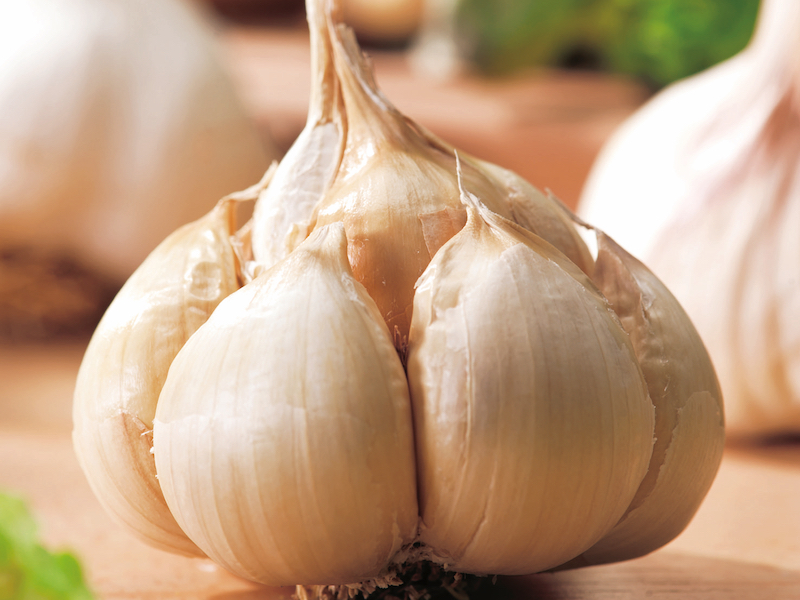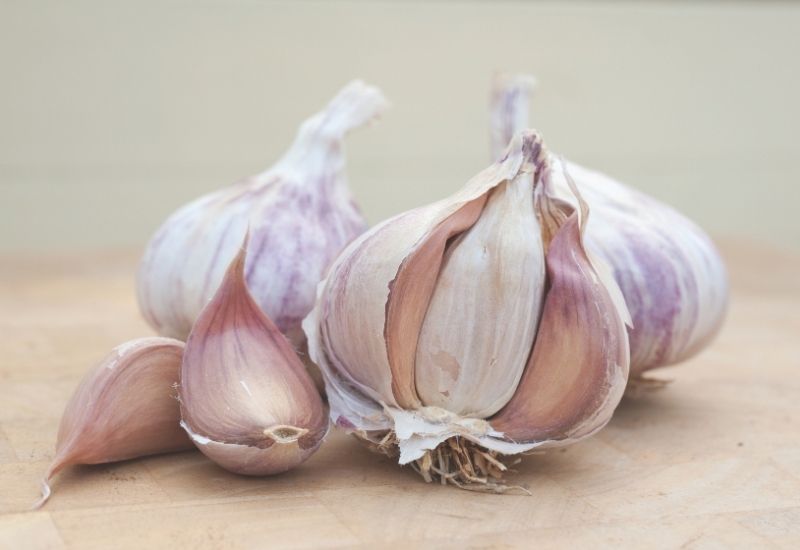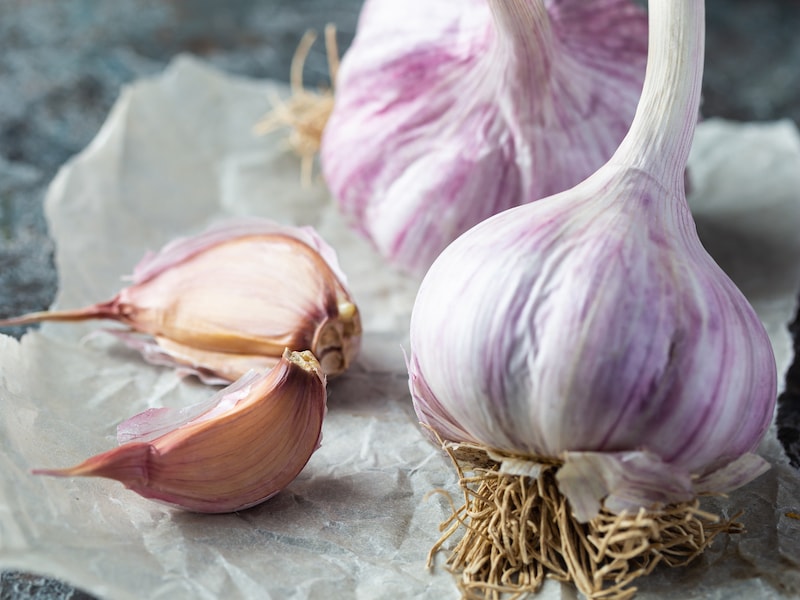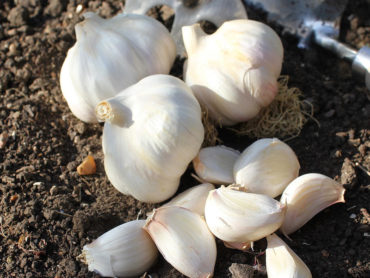If you’re looking for an easy crop that stores well and provides brilliant flavour for all your favourite dishes in the kitchen, buy some garlic bulbs for planting. Planted in autumn or spring and harvested in summer, it may have a long growing season, but this member of the allium family needs very little care and attention along the way. We’ve searched the internet for the best independent articles, videos and Instagram posts to help you harvest a bumper crop. Here’s our shortlist of excellent expert advice for growing garlic.
Contents
- Best advice on soft neck and hard neck garlic varieties
- Best advice on when to plant garlic bulbs
- Best advice on where to grow garlic
- Best advice on how to plant garlic bulbs
- Best advice on how to deal with pests and diseases
- Best advice on how to harvest and store garlic
Best advice on softneck and hardneck garlic varieties

Carcassonne Wight is an exceptional hardneck variety that’s very successful in the UK
Image: Garlic ‘Carcassonne Wight’ from Suttons
Garlic comes in two main varieties – hard-neck and soft-neck – explains Jamie from @nettlesandpetals. Hard-neck is better for cooler climates and develops an edible flowering stalk or ‘scape’ that needs to be removed. Soft-neck varieties produce leaves rather than a stem, and are better suited to warmer conditions. You can plant store bought garlic bulbs, says Jamie, “but they can carry disease and are often sprayed with anti-sprouting agents. So I wouldn’t bother.” Watch his short reel for helpful growing tips.
In her comprehensive guide to growing garlic, Tanya at Lovely Greens enthuses that both varieties are delicious, adding that hardneck is less commonly grown but has a more complex, “gourmet” flavour, while the milder softneck will produce larger and more plentiful cloves. Softneck can be planted in autumn or spring and it stores well too.
When she’s cooking, Jessie at Plot 37 gets frustrated by garlic that’s difficult to peel, so she grows hardneck varieties for their looser skin, even though the harvested bulbs won’t store for as long as softneck types. In her chatty video you’ll find her planting out pink-skinned Carcassonne garlic in October.
Mandy at Mandy Can U Dig It grows hardneck garlic because of the welcome bonus crop offered by the flower stalk scapes. Considered a delicacy in France, she says they’re distinguished by their more delicate garlic flavour.
Softneck garlic can also throw up some surprise bonuses, according to Nick of Two Thirsty Gardeners in his post on garlic bulbils and corms. Some of his crop sprouted cloves half way up the stems. He recommends snipping these off – and using them in your cooking – so the plant’s energy goes into producing bigger bulbs underground.
Best advice on when to plant garlic bulbs

‘Messidrome’ is a softneck variety that has been bred to store well
Image: Garlic ‘Messidrome’ from Suttons (©Floramedia)
In her down to earth post on planting autumn garlic, Claire at Claire’s Allotment subscribes to the view that garlic needs cold weather in order for the bulb to split into cloves effectively. She also shares the secret to giving spring garlic a head start by sowing in January in toilet roll tubes in the greenhouse or cold frame so it has already begun to grow when planted out in the soil.
Looking for an explanation of the cold snap theory as an essential part of garlic growing, Becky at @sow_much_more checked out the science. She discovered that the process of cold exposure followed by activation of the bulb is called vernalisation and you can simulate the effect by putting your garlic bulbs in the fridge for a few days before planting.
An advocate for sowing garlic under glass in winter and planting out in spring, John at Allotment and Gardens says this is particularly helpful if you’re running late with your sowing schedule. You can even get an earlier crop this way than you would by sowing direct in autumn.
Best advice on where to grow garlic

Varieties like Germidour can be planted in spring and autumn
Image: Garlic ‘Germidour’ from Suttons (© Thompson and Morgan)
In her great guide to growing garlic, Pumpkin Beth advises you to sow it in as bright and sunny a position as possible, or at least only partial shade. She also recommends a raised bed so that you can fill it with the best sandy or silty soil that your garlic can thrive in.
Also opting for a wooden raised bed option is Kirsty at @my_little_allotment whose photo shows her garlic cloves in position before being covered with soil, neatly spaced out to allow plenty of room for the bulbs to slowly develop into handsome specimens.
James from @a_life_in_the_garden grows garlic in raised beds at his allotment. One of his very favourite things to grow, he says it’s a great beginner crop to get children involved. After all, who can resist garlic bread made from homegrown bulbs?! “It’s so easy, we literally dress the beds with well rotted manure, then plant each garlic clove. That’s it…” Follow him for lots more family-friendly gardening tips.
Best advice on how to plant garlic bulbs

‘Eden Rose’ is a high-yielding hardneck that grows well in colder parts of the UK
Image: Garlic ‘Eden Rose’ from Suttons (autumn planting variety)
It’s important to prepare your garlic bed before you sow your cloves, says Rekha of Rekha’s Garden and Kitchen. An organic gardener, in her detailed post on growing garlic, she explains how she digs green manure into her soil at least two weeks before sowing, although you could also use good quality compost to enrich the plot.
John at Allotment and Gardens agrees it pays dividends if you prepare the soil in advance, giving it a feed of general fertiliser or blood, fish and bone a fortnight ahead of sowing garlic. If you have heavy clay soil, dig a deeper hole and put some grit or sand under the cloves when you sow them, to improve drainage.
In Charles Dowding’s comprehensive and easy-to-follow video guide for garlic growers, he shows his no fuss method for sowing garlic in no-dig beds between October and December. He makes a small hole with a dibber and selects the biggest cloves to pop in the ground, not too deeply, and finishes off with his regular autumn surface dressing of good quality compost.
In her clear and concise growing garlic guide, Carol, aka The Sunday Gardener, runs through the essentials for sowing garlic cloves, following the same procedure in either autumn or spring. She starts by breaking her garlic bulbs into cloves as you would when cooking, then she simply plants each one with the pointy end upwards, covering it with around 2.5cm of soil.
Best advice on how to deal with pests and diseases

Order a curated collection of hardneck and softneck garlic varieties for a range of flavours
Image: Garlic Lovers Collection (Autumn) from Suttons
In her handy post on garlic growing, Mandy at Mandy Can U Dig It explains that garlic suffers from similar pest and disease problems as other members of the allium family, like leeks and onions. She identifies and offers remedies for common challenges like split bulbs, green cloves, top sets, leek rust and white rot.
Garlic rust is the chief enemy to watch out for according to Rekha of Rekha’s Garden and Kitchen. Among her wealth of tips on how to grow garlic – the first ever crop she grew on her allotment – Rekha explains that rust is a fungal disease that’s encouraged by warm, wet weather and the best way to deal with it is by removing and destroying the affected leaves.
Liz at Byther Farm finds that birds are attracted to her garlic bed, pulling the cloves out of the ground before they have a chance to get established. In her excellent garlic planting video she demonstrates how to protect them using netting supported by hoops.
Best advice on how to harvest and store garlic

Mesh vegetable sacks are a great way to store garlic
Image: Shutterstock
Charles Dowding is a firm believer in harvesting garlic early before the outer skins of the bulbs get a chance to rot underground, and to limit the effect of any leaf rust. His comprehensive video demonstrates easy ways of harvesting, drying and storing garlic so that it lasts you for months.
Simon at Garden of Eaden says autumn-planted garlic should be ready to harvest in June or July, and it’s time to lift garlic bulbs when the leaves wither and turn yellow. He advises loosening bulbs from the soil very carefully with a trowel – damaging them at this stage will affect their suitability for storage.
Mothin Ali at My Family Garden has all the answers about when and how to harvest garlic in his very informative video. His special tip is to make sure that it hasn’t rained for a couple of days before you harvest because fresh water taken on by the plant will make it harder to dry and store the bulbs.
After digging up his garlic crop, Tony at Simplify Gardening cures the bulbs by hanging them upside down in a mesh tray for maximum air circulation as they dry. To store hardneck garlic, his informative video on harvesting advises cutting the stems around 2in from the bulb, removing the roots, then keeping the bulbs in a tray or net bag in a cool, dark place.
In her video on harvesting and storing garlic, Tanya at Lovely Greens shares her tips on how to braid softneck garlic for long-term storage. After digging up her garlic, she lets it dry out on the ground first, then keeps it in a damp-free place like the garage for a couple of months before she plaits the stems together. An added bonus is that the plaits and bulbs make a great feature hanging up in the kitchen.
Growing your own garlic couldn’t be simpler, especially now you’re armed with excellent advice from the experts on choosing, positioning, planting, nurturing and harvesting. A few months from now you could be squirrelling away a fine crop of garlic that will keep you supplied right through the year.
Lead image: Garlic ‘Carcassonne Wight’ from Suttons
Last Updated on December 3, 2025 by Suttons Horticultural Team






Can I just say thank you for this post. Collating a selection of experts blogs and videos is genius and has made what might have taken me hours of searching and reading and debating a very enjoyable read and I now feel ready for garlic planting. It’s our second year growing it and still learning each time.